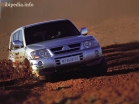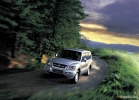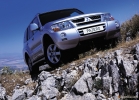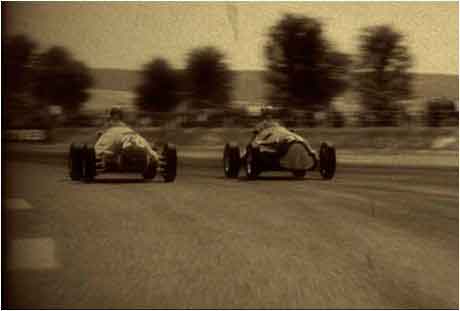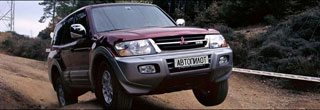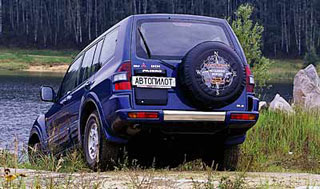Test drive Mitsubishi Pajero (Montero, Shogun) LWB 2000 - 2003 SUV
Solaris
 From the time, the legs of Bush finally crushed domestic agriculture for themselves, and the tractor drivers remained only in the cinema, the word diesel is associated with many exclusively with clothes. And in vain.
From the time, the legs of Bush finally crushed domestic agriculture for themselves, and the tractor drivers remained only in the cinema, the word diesel is associated with many exclusively with clothes. And in vain. I fight about the laying that the image of the intelligent engineer Rudolf Diesel, who invented at the end of the 19th century a new principle of operation of the internal combustion engine does not stand before your eyes. Most likely, from the memoirs, a summer cottage, an eternally drunk tractor driver in a saturated stinking quilted jacket comes out. Or a trucker, touching with a blue frosty morning under his ointment with a soldering lamp in his hands. Of these associations, persistent idiosyncrazia of Russian car owners to diesel engines has grown.
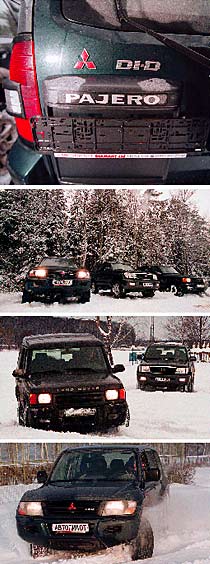 A short course of physics. In fact, diesel, especially modern, in its design and appearance, does not differ from the usual gasoline. It uses the same nodes and the same geometry. But all the details subjected to loads in the process are reinforced, because the degree of compression in diesel engines is two to three times higher than in gasoline engines.
A short course of physics. In fact, diesel, especially modern, in its design and appearance, does not differ from the usual gasoline. It uses the same nodes and the same geometry. But all the details subjected to loads in the process are reinforced, because the degree of compression in diesel engines is two to three times higher than in gasoline engines. This is due to a fundamentally different scheme for the formation of the fuel mixture and its combustion. In most gasoline engines, a pair of gasoline is first mixed with air in the intake system (carburetor or injector). This cocktail enters the cylinders, where it is ignited by the spark plug.
In the diesel engine, the air enters the cylinders. When, in the process of compression, it heats up to the temperature of the fuel self -ignition (about 800C), then the fuel is supplied through the nozzles to the cylinder, which explodes, and the process has gone, the car drove. Such is the primitive scheme of the simplest diesel.
Green exhaust. A primitive motor working on diesel fuel really resembles a compressor for road work, which causes a feeling of disgust. And no one will install such an engine in a substantial machine worth several tens of thousands of dollars.
But since the time of Rudolf Diesel, science has known more than one trick, and most automakers install diesel engines on almost all their models. Moreover, in Europe a real diesel boom is now observed-primarily due to the fact that diesel fuel is cheaper than high-octane gasoline, and a smaller amount is required for the same number of kilometers passed. Hence the high economy of engines, this is first. Secondly, despite the color of the exhaust-sometimes a cloud of black smoke breaks out of the pipe-when working on a poor mixture in black smoke, it contains much less carbon monoxide. It turns out that diesel is more environmentally friendly. And, finally, the most important thing - diesel engines have a high torque in various ranges of the crankshaft rotation frequency. This is ideal for work in difficult road or off -road conditions. So, it is most interesting to install it on jeeps.
Based on this, the autopilot decided to just ride. Moreover, necessarily on SUVs, of course, the most popular in our country. Prestigious. Well -known to our readers and therefore do not require a repetition from us in the description of the comfort of the salon and numerous off -road bells. We were interested in something else - dynamics and noise. All models are diesel.
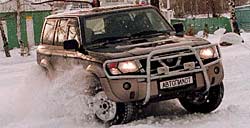 Under a quiet growl. We paid special attention to the noise level in the cabin - these four cars are equipped with the most modern engines with direct fuel injection, what is called Direct Injection. Hence, by the way, the abbreviations of DI-D on Pajero and Di on Patrol. The main difference between such engines and classic diesel engines is in the design of the combustion chamber.
Under a quiet growl. We paid special attention to the noise level in the cabin - these four cars are equipped with the most modern engines with direct fuel injection, what is called Direct Injection. Hence, by the way, the abbreviations of DI-D on Pajero and Di on Patrol. The main difference between such engines and classic diesel engines is in the design of the combustion chamber. Direct injection means that the fuel is supplied directly to the engine cylinders, into a small space above the piston, and the combustion chamber is embedded in the body of the piston. Hence the name - unrequited. The classic diesel is equipped with a separate vortex chamber of combustion associated with the cylinder of a narrow channel. Flying through it, the air is intensively twisted and mixed well with the fuel. With this scheme, the level of detonation and noise is much less than on direct injection engines. Actually, such diesel engines were more used for installation on cars. It seems that they are not looking for good from good, but direct injection is more progressive in terms of fuel saving, increasing power and reducing the level of exhaust toxicity.
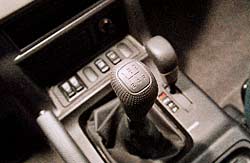 Modern electronic control of high -pressure pumps (high -pressure fuel pumps), which pump up the diesel fuel in the combustion chamber, the use of a multi -valve inlet/release system and other new technologies allowed the use of Direct Injection on relatively compact engines. Each company came to this in its own way, but the essence of the same is the electronic control of the amount of injected fuel, increasing the pressure pressure, which made it possible to achieve the effect of a vortex chamber. Land Rover engineers even used individual pumps on the nozzles of each cylinder, abandoning the fuel pump.
Modern electronic control of high -pressure pumps (high -pressure fuel pumps), which pump up the diesel fuel in the combustion chamber, the use of a multi -valve inlet/release system and other new technologies allowed the use of Direct Injection on relatively compact engines. Each company came to this in its own way, but the essence of the same is the electronic control of the amount of injected fuel, increasing the pressure pressure, which made it possible to achieve the effect of a vortex chamber. Land Rover engineers even used individual pumps on the nozzles of each cylinder, abandoning the fuel pump. The power of all four engines is increased due to the use of boost. Unlike gasoline engines, it works at almost any engine frequency - the spatula is rotated by the spent gases, and the degree of compression in the diesel engine, we recall, is much higher. And Mitsubishi and Nissan have the highest degree of engraving of engines - the turbocharger is also equipped with an intermediate air cooling radiator - Intercooler.
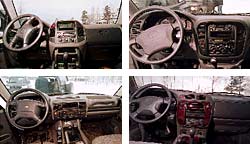 For friendly neighing. All four cars are rather quiet inside. Of course, they cannot be compared with gasoline versions, but with a radio turned on, the shitty diesel sound practically does not cut the ear. At idle, especially on a heated motor, it even somewhat reminiscent of the uterine grunts of a large and kind dog.
For friendly neighing. All four cars are rather quiet inside. Of course, they cannot be compared with gasoline versions, but with a radio turned on, the shitty diesel sound practically does not cut the ear. At idle, especially on a heated motor, it even somewhat reminiscent of the uterine grunts of a large and kind dog. The noise begins to actively penetrate the salon only when the revolutions exceed 4 thousand revolutions. As a rule, this occurs at the time of a sharp set of speed on the freeway or when the engine operates in the most intense mode. This is when a low gear is turned on, all locks, and you are trying to get out of deep, sorry, pits. In the first case, you can make the radio louder, in the second - no one pays attention to this, passionate about the jeeping process.
My subjective opinion is the leader in the sound insulation of Toyota Land Cruiser. The second place was divided by Nissan Patrol and Land Rover Discovery. Mitsubishi Pajero - on the honorary third.
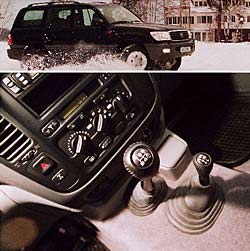 The dynamics of all four cars was at a decent level, and Mitsubishi Pajero confidently escaped in the first place in this nomination. This is the only car that instantly responds to press the gas pedal - almost like a gasoline version. The advertising slogan feel the difference in this case is inappropriate. Even if you compare passport data on acceleration to hundreds and maximum speed, then the diesel version is inferior to gasoline for only a couple of seconds.
The dynamics of all four cars was at a decent level, and Mitsubishi Pajero confidently escaped in the first place in this nomination. This is the only car that instantly responds to press the gas pedal - almost like a gasoline version. The advertising slogan feel the difference in this case is inappropriate. Even if you compare passport data on acceleration to hundreds and maximum speed, then the diesel version is inferior to gasoline for only a couple of seconds. The difference between the other three participants in our test was insignificant. All of them are very quickly promoted to maximum revolutions and quickly gain 60 km/h laid in the city, only a little lagging behind Pajero on the highway. And they are all distinguished by amazing elasticity in increased gears; To overtake other cars on the highway is just a pleasure. When the fourth gear turned on, it is quite possible to slow down to 40-60 km/h, and then confidently accelerate back to a hundred.
The behavior of Toyota and Nissan frankly pleased us in direct, fifth gear. When driving at a speed of 110--120 km/h, a pretty decent stroke reserve remains under the gas pedal. And this is not a fiction - with a sharp pressing on the pedal, jeeps are easily accelerated from 120 to passports 170 km/h in just a few seconds.
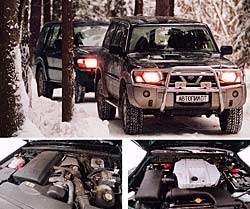 We practically did not have to evaluate the charm of diesel jeeps on the off -road - for several reasons. Firstly, three out of four cars were shod in an inappropriate rubber for such a case. Secondly, the task did not stand. This time we wanted to evaluate the operational qualities of diesel engines in a normal, and not in a combat situation. And we will deal with a jeep somehow another time and will definitely take a gasoline counterpart with us for comparison. On off -road rubber.
We practically did not have to evaluate the charm of diesel jeeps on the off -road - for several reasons. Firstly, three out of four cars were shod in an inappropriate rubber for such a case. Secondly, the task did not stand. This time we wanted to evaluate the operational qualities of diesel engines in a normal, and not in a combat situation. And we will deal with a jeep somehow another time and will definitely take a gasoline counterpart with us for comparison. On off -road rubber. This time we allowed ourselves only to go quietly on the Snow Virgin. But for a diesel, this is not a test, but a children's game. We connect all -wheel drive, put the second lowered and forward - the gas pedal can not be touched. Under a quiet growl, the diesel crawls on its own. Try repeated on gasoline.
I am capricious - this is a minus. The main argument of the opponents of the diesel engine is difficult to launch it in cold weather, despite the pre -heating system, which all modern machines are equipped with. Candles of incandescent are inserted into the combustion chambers, which after turning on the ignition are heated to 800 - 900C, after which the engine is ready to launch. The power supply is automatically removed after that. In the summer, the control bulb of heating goes out after 3-5 seconds, in winter this process can take this entire 20. We collided with this rather early morning on the day of the test race in the Grand Volga region. During the night, the temperature fell to -21C, although in the evening it was wet and dirty on the street. But all the cars are new, and therefore started without problems.
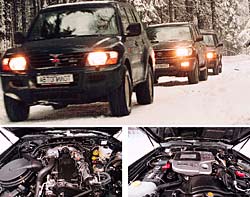 Ha, a stubborn fan of gasoline engines will say, new ones are getting better. Let's see how the old engine will behave. Yes, and the battery candle can suck in just a couple of weeks of stable frosts.
Ha, a stubborn fan of gasoline engines will say, new ones are getting better. Let's see how the old engine will behave. Yes, and the battery candle can suck in just a couple of weeks of stable frosts. We were convinced that such a skepticism in relation to modern diesel is not applicable. Firstly, all four jeeps have two batteries, which increases the reliability of the entire system. They are connected through a special relay and work on the category in turn, as they are charged. By the way, no one will give a lifelong guarantee on the battery on gasoline engines. Well, a maximum of two years.
Moreover, the manufacturers took into account another annoying factor that overshadows the life of Russian tractor drivers - the low quality of diesel fuel. Due to the increased content of paraffin in severe frost, the fuel fuel, clogs the fuel highway, and the diesel stalls, having worked after the launch of a minute or two. A trucker with a soldering lamp in the position of a man from below comes to memory. But you and I are not on MAZ - in Nissan Patrol, Mitsubishi Pajero and Toyota Land Cruiser, there was a key to turning on the warning system of the entire fuel line. In Land Rover, such a system is set by order. In the struggle for survival in harsh conditions, the system can play a decisive role - thank God, we did not have to use it.
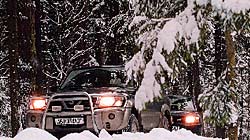 But cheap is a plus. Returning to the editor, we poured one hundred grams from the frost and took up the calculator. The cost of domestic diesel fuel is in Moscow an average of 7.3 rubles. Owners of gasoline versions prefer to refuel 95th (9 rubles. 30 kopecks), although all jeeps can well ride on the 92nd. The average consumption of diesel fuel per 100 km in the city is 12 liters, gasoline fluctuates between 17 and 23 liters depending on the model (on average - 20 l). According to the most approximate estimates, the savings are 8 liters or about 100 rubles per hundred kilometers passed. The average monthly mileage is 1,500 km - saving 1.5 thousand rubles. In the year - 18 thousand to a minimum. For a person ready to lay out from 30
But cheap is a plus. Returning to the editor, we poured one hundred grams from the frost and took up the calculator. The cost of domestic diesel fuel is in Moscow an average of 7.3 rubles. Owners of gasoline versions prefer to refuel 95th (9 rubles. 30 kopecks), although all jeeps can well ride on the 92nd. The average consumption of diesel fuel per 100 km in the city is 12 liters, gasoline fluctuates between 17 and 23 liters depending on the model (on average - 20 l). According to the most approximate estimates, the savings are 8 liters or about 100 rubles per hundred kilometers passed. The average monthly mileage is 1,500 km - saving 1.5 thousand rubles. In the year - 18 thousand to a minimum. For a person ready to lay out from 30 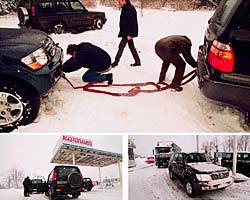 up to 50 thousand per car, these are not so big numbers, but still nice.
up to 50 thousand per car, these are not so big numbers, but still nice. And here is another very important plus. The farther we drove away from Moscow along the Dmitrovskoye Shosse towards the Volga, the less often we met a gas station. And at the stations themselves, the AI-95 signs were increasingly replaced by diesel signs. The outback still lives on the requirements of tractor drivers and truckers. The situation is not critical, like ten years ago, but refueling on a diesel engine is much easier. And not even 7.20, but much cheaper. Pollitra still remains a universal payment in our country.
Well, for diesel!
Text Nikolay Kachurin, photo Dmitry Azarov
Source: "Autopilot"
Mitsubishi Pajero (Montero, Shogun) LWB 2000 - 2003
Mitsubishi Pajero (Montero, Shogun) LWB 2000 - 2003
Mitsubishi Pajero Faults 5 doors: Detailed information| Pajero (Montero, Shogun) LWB 2000 - 2003 | |
|---|---|
| Engine |  |
| Transmission |  |
| Control system and suspension |  |
| Brake system |  |
| Air heating and air conditioning |  |
| Launch and charging system |  |
| Electric components and so on |  |
| Corrosion body stability |

